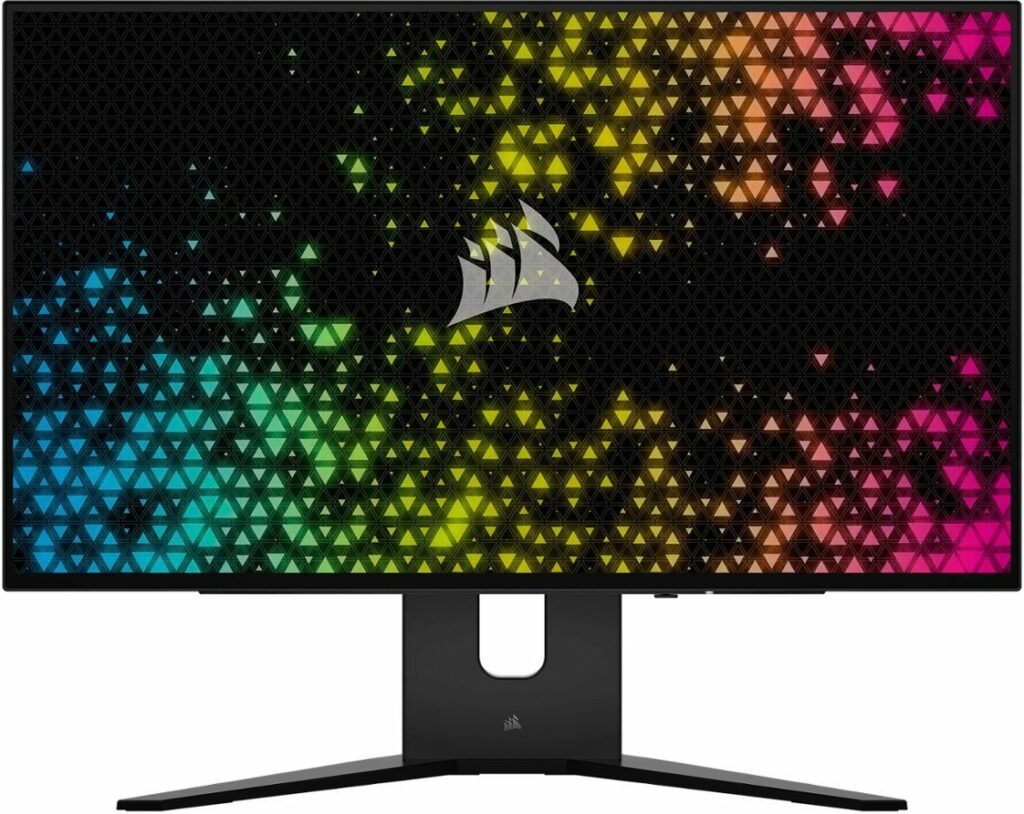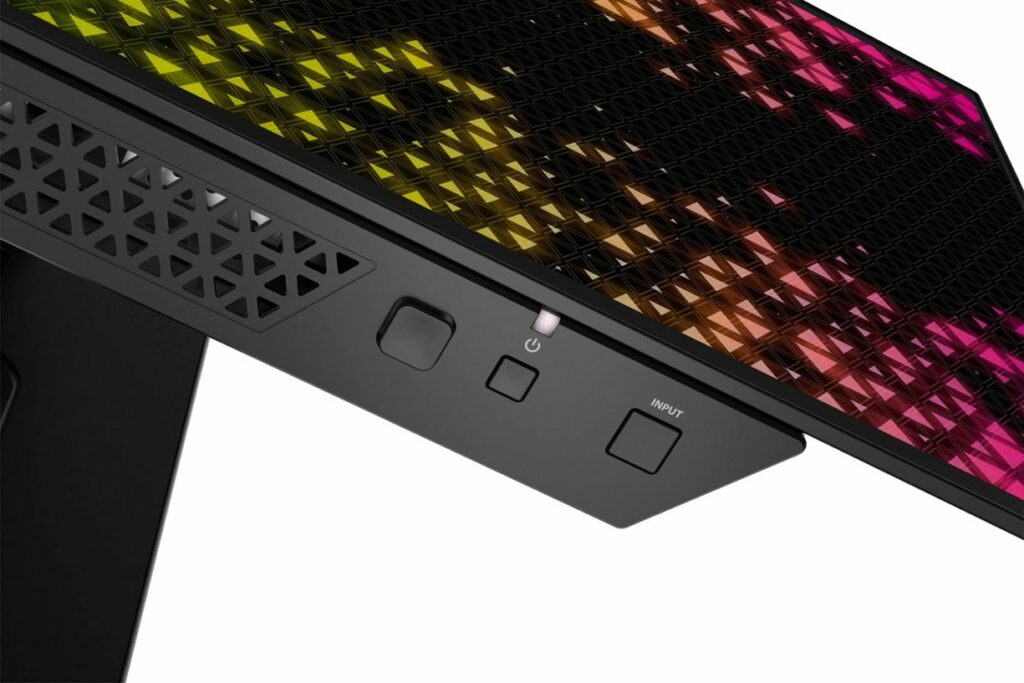The Corsair Xeneon 27QHD240 offers fantastic gaming imagery courtesy of its naturally fast OLED panel. It arrives after the brand’s experiment with flexible OLED, making their first series of gaming monitors all the more impressive. It’s expensive and has brilliant competitors like the Asus PG27AQDM and LG 27GR95QE-B, so let’s see how it compares.
Corsair Xeneon 27QHD240 Specifications
- Screen Size: 27 Inches
- Resolution: 2560 x 1440 QHD
- Aspect Ratio: 16:9
- Panel Technology: OLED
- Refresh Rate: 240Hz
- Response Time: 0.03ms
- Contrast Ratio: 1500000:1
- Brightness: 450 cd/m2 (1000 cd/m2 Peak)
- Built-in Speakers: None
- Stand: Height – Yes
- Stand: Tilt – Yes
- Stand: Swivel – Yes
- Stand: Pivot – Yes
- VESA Compatibility: Yes (100 x 100)
- Connectivity: DisplayPort 1.4 x 1, HDMI 2.1 x 2, USB-C DP Alt Mode x 1, USB 3.1 x 5, 3.5mm Jack x 1
- Dimensions with Stand (WxHxD): 23.8” x 20.8” x 8.83”
- Weight: 13.88 lbs
Design and Features
The Corsair Xeneon 27QHD240 looks more like an ultra-high-end display rather than one made for gaming. It has a matte black finish that goes well with its sleek design, and is very easy to maintain its clean look. The display is bezel-free, but you still get inner borders like the other QD-OLEDs we’ve seen recently.
It’s sleek and slim, so it requires most of the 8.83 depth because of its boomerang-shaped base. We imagine that its going to be manageable for users with typical desk sizes since it is not gigantic like its 45-inch sibling. It’s also considerably lighter at 13.88 pounds, so it should be easy to move around if you want to rearrange your setup.
The monitor’s build quality is great since Corsair is known to use premium materials and craftsmanship for many of its products. The plastics used are thick and sturdy, and there were no signs of cosmetic defects, usually caused by poor quality control. The included stand is firm and stable, so the thin screen won’t sag or wobble while it’s in use.
One unique feature of this monitor is its proximity sensor, which launches on-screen shortcuts showing you where the buttons are. It shows you where the joystick, power button, and input switch are, so you don’t have to tilt or fumble with the monitor in the dark. It’s a quirky and unique implementation, but we like it and sincerely hope it catches on.
You can also use the brand’s iCue software to control some of its features and capabilities. It’s a must-have if you already have Corsair gear since it basically unifies your setup’s lighting and functionalities. However, iCue has a love-or-hate following in the gaming world, so users who don’t use the brand’s peripherals and PC parts might not like having to use it.
The included stand with the monitor looks gorgeous, but it’s also quite functional. It offers tilt, swivel, pivot, and height adjustments, so getting a good angle for hours of gaming is easy. You can also use VESA mounts, but we’d rather have the designed setup unless desk space is minimal.
The Corsair Xeneon 27QHD240’s connectivity layout includes DisplayPort 1.4 DSC, two HDMI 2.1 slots, and a USB-C port with PD Alt Mode. It also has five USB 3.1 ports for accessories and a 3.5mm jack for headphones. It doesn’t have speakers, but that’s okay since the cabinet is too thin to include a powerful set.
We like that Corsair made a genuine effort to help with cable management for this monitor. They separated the video inputs and placed the USB slots on the opposite side of the chassis so you could efficiently arrange your cables. It also has a large cable-tidy hole on its stand for easy passage of every wire you will use with it.
Display and Performance
The Corsair Xeneon 27QHD240 boasts a 27-inch OLED panel with a 2560 x 1440 resolution, a 240Hz refresh rate, and a 0.03 response time. The backlight has a 450 cd/m2 output and a 1000 cd/m2 peak, while its contrast is listed at 1500000:1. This model isn’t HDR certified, but it surely is capable of better HDR performance than the HDR1000 mini-LED monitors due to its naturally infinite contrast.
27-inch 1440p monitors are very comfortable to use, so they are still in circulation with newer and more impressive variants. They are also less demanding on GPUs, so reaching a higher refresh rate is easier, even if you don’t have a flagship card. It’s easy on the eyes regarding visibility and legibility, so it is also great for productivity.
The Corsair Xeneon 27QHD240 covers more than 100% sRGB, 97% DCI-P3, and 92% of the Adobe RGB gamut. Its default accuracy had a deltaE average of 2.18, so it’s good to go out of the box. Most users won’t feel the need to calibrate the monitor for gaming or daily use unless they plan on using it for color-critical work.
Calibrating the monitor with a colorimeter reduced the dE average to 1.03, so it is suitable for editing and content creation. However, you must get the colorimeter to achieve a similar result. Copying settings or ICC profiles won’t do that for you instantly since every panel has different color characteristics.
Its OLED panel reached 312 cd/m2 in SDR, but it peaked at 705 cd/m2 when it displayed HDR content. Its contrast was virtually infinite, resulting in perfect black luminance like every OLED monitor out there. This is where mini-LED monitors can’t compare to it since each pixel transitions individually instead of relying on a backlight.
Panel uniformity for the review unit did not show any backlight leaks or clouding since it doesn’t have a backlight. Dark scenes looked even all throughout, so you won’t get an annoying glow on the sides of the viewing area. This is another advantage of OLED tech, but it can be offset by burn-in if you aren’t careful with the monitor.
Its pixel response time is impeccable as well, so there is no sign of blurring or ghosting in contrasting transitions. The 240Hz refresh rate complements this, making it your best pick for E-Sports gaming. It is another advantage that makes OLED so desirable for the gaming market.
The Corsair Xeneon 27QHD240 is compatible with both FreeSync and G-Sync for tear and stutter-free gaming. Its essential to have compatibility with both brands since they have compelling 1440p cards with competing price points. Input lag sits at 3ms at 240Hz, making it one of the fastest 1440p displays around.
Thoughts on the Corsair Xeneon 27QHD240
The Corsair Xeneon 27QHD240 is a fantastic choice for gamers who want speed and gorgeous eye candy. Its OLED panel brings every advantage it could, making it considerably better than the most sophisticated IPS or VA models out there. It also looks gorgeous and is equipped with plenty of features, so it’s an excellent investment.
However, the biggest hindrance for this model is its price which some may consider to be too rich for a 1440p display. It’s also an OLED display, so it is prone to burn-in if you are not careful with it. But overall, it is an excellent buy, especially since it has HDMI 2.1 and USB-C connectivity.
Pros:
- Fantastic Colors and Contrast
- Attractive Design
- HDMI 2.1 USB-C Connectivity
- Proximity Sensor Feature
Cons:
- Expensive
- Prone to Burn-in
About the Author: 





Leave a Reply